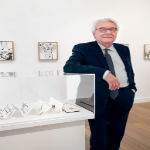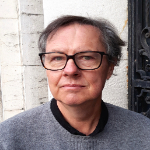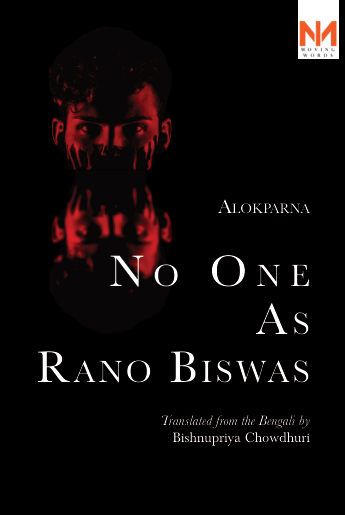TRANSLATED FROM THE FRENCH BY JOHN TAYLOR
If it were proven that the depth of an oeuvre can be measured by the extent of the paradoxes embodying it, then Rogier’s work would be in the forefront. Yet this criterion is not needed to confirm what the simple experience of looking demonstrates. Rogier van der Weyden enters Art History with a masterstroke. The first painting of his known to us, The Descent from the Cross, which is in the Prado, was not surpassed during a life of artistic labor.
Here are the paradoxes. It is a painting, but it represents a sculpture. The panel is flat, but the effects of relief are so abundant that they nearly create a trompe-l’oeil. One needs only to enumerate the successive geometric planes established between the foreground and the background. First of all, Golgotha and the bones in the foreground conceived as an extension of the ground on which we, as spectators of the painting, are supposedly standing. That is, spectators of the painting or of the sculpted panel represented by the painting, if not of the life-size drama itself played out once again in front of us. A living drama in the present, and its colors have not faded!
A wide-hipped Virgin clothed in intense blue has collapsed out of sorrow. Slightly withdrawn, Saint John bends down towards her and holds her up. Behind the Virgin, who has fainted, are her two sisters, Mary of Clopas, who has veiled her face, and Mary Salome. Then comes the central, transversal plane with Christ’s body. Behind him stands Joseph of Arimathea, recognizable because of his beard; he is carrying Christ by his armpits while Nicodemus, wearing a gold-trimmed coat, is propping up his legs. Behind Joseph is the upright post of the Cross, which is the center of the composition, and behind the Cross, the ladder on which a young man in blue is perched. His right hand, which extends above the horizontal wooden bar of the Cross, is still clutching the last nail removed from the crucified man’s hand. Finally, behind all this, the gilded backdrop of the wooden frame on which is supposedly sculpted the scene at which we are looking. No less than seven successive planes, ranging from the foreground to the background, are thus established in the necessarily restrained depth of the altarpiece itself containing the imaginary sculpted bas-relief whose appearance is, in fact, painted.
The ultimate paradox: from this representation of a representation emerges an unequaled presence, the presence of a scene that comes alive and takes place before our eyes. (A few weeks after having written these lines, in February 2022, during a rainy morning, I was once again in the Prado. I headed directly to the painting by this artist whom I like to call Roger de la Pasture. You walk through a few rooms that contain marvels: Robert Campin’s Saint Barbara, who is reading near a fireplace in a strikingly shortened perspective; then the polyptychs of Memling and de Bouts; but no sooner have you turned your head towards the painting by van der Weyden, you cannot help but be grasped by its force: it shines forth, eclipsing all the others. After long examining and admiring the Virgin’s finely transparent tears, you can still gaze at the painting from afar, from the back of the adjacent room. Its sculptural power and intense effects of relief then take on all their force.)
“A composition worthy of Hollywood,” proclaims David Hockney while we are looking at reproduction of it. “Imagine the studio personnel whom he must have had around him, a prop crew, model managers, costume makers, a lighting designer. . .and that technicolor effect!”
Indeed, it is evident that Rogier had his models pose like actors taking on their respective roles. The faces are so precise, so different among each other, that they could not have been invented; they are the faces of the models who posed for the artist. On a sidewall of the same room hangs another of Rogier’s paintings, a Pieta. The Saint John holding up the Virgin is exactly the same, with the same nose and curly hair. The models kept their jobs from one painting to the next.
In Pliny the Elder’s beloved game of “This is the first time that. . . ,” Rogier could have claimed an Oscar for this painting for many a reason. First of all, for the composition: the parallelism of the Virgin’s collapsed body, on the ground amid the bones, and the lifeless body of Christ in the hands of Joseph and Nicodemus as if it were suspended, floating, even flying—a body without convulsions, serene, in abandon, without will and yet commanding the entire composition. The two bodies have the same oblique position; their arms echo each other, the right one hanging down, the left one folded into a right angle. . . This parallelism indicates that the palpable sorrow expressed by Mary participates in Christ’s redemption as if she were about to give her own life so that he could find his once again. The Virgin’s hands and cheeks have a cadaveric pallor to them compared to the rose-colored body of Christ, who seems to have dozed off more than died. “It is he who is alive and I who am dead,” Mary seems to say.
Another innovation: the tears. No artist before Rogier had painted tears on a face like that. The Virgin’s mouth is half-opened; the white line of her upper incisors can be glimpsed; her eyelids are heavy, with dark circles; her brow is knitted in affliction and tiny pearl-like tears illumined by a streak of white paint are rolling down her cheeks.
The tears wept by Mary of Clopas, who is standing in the left corner, are no less true-to-life. She is grasping a handkerchief in front of her eyes, or perhaps it is a part of the white veil hair-pinned onto her head (the hairpin high above her forehead is visible) and covering her ears, her neck, and her shoulders.
Motionless and glistening, Mary’s tears still flow for us who visit the Prado today. And how not notice that Picasso, who never better expressed his novel vision than when he was journeying through art history, had these tears in mind when he painted the face of Dora Maar weeping out of jealousy? (And via Picasso, Antonio Saura, who turned these portraits into one of his favorite themes. I never spoke with him about this, but the colossal art-history library in his studio compels one to believe that the reference was not coincidental.)
Jorge Luis Borges, more attentive than anyone to recurrent forms over the passage of time, would not have failed to ask if these tears were not the same tears that flowed from Mary’s and Dora’s eyes. But Borges was almost blind and he preferred libraries to museums.
Are they the same tears? I don’t know. In Picasso’s painting, they do not glisten and roll like pearls; they spring forth like darts, the living reproaches of an abandoned, humiliated woman.
On the other side of the painting, Mary Magdalene wrings her hands in sorrow. Her hair is covered with a cap but her ear, her neck, her back, and the beginning of her breasts are naked. This unlikely pose—her right arm raised above her head, her neck bent—(another “first time” results from the way Mary Magdalene is depicted here) also crops up in Matisse. 1940, Hôtel Regina, Nice: Matisse has Lydia Delectorskaya, his new assistant, pose for him. He makes several portraits of her, including the different versions of the famous Romanian Blouse. One of these, titled The Dream, takes up once again the precise bodily position of Rogier’s Mary Magdalene, but effaces her sorrow and replaces it with gentle, serene sleeping, her head lying in the crook of her elbow and inhabited by the dream. Via Rogier, Matisse tells us that painting is avowal and that he sees in Lydia a Mary Magdalene’s sensual curves.
Such is the miracle of art: an image finds the proof of its power in the image that another artist draws from it, centuries later, in order to say something else. But for this miracle to happen, that something else needs to be something lasting: Dora’s jealousy, Lydia’s charm.
And the miracle does not end there. Here is what happened to Rogier’s painting and why Picasso and Matisse, like all of us, might have been forever deprived of it.
Mary of Hungary, to whom her brother Charles V had entrusted the government of the Low Countries, loved the arts. When she saw Rogier’s Descent from the Cross in the Chapel of Our Lady Without the Walls in Leuven, which belonged to the Guild of Crossbowmen of the town, who were the artist’s benefactors, she wanted it at all costs. As a skillful negotiator, she offered in exchange a copy commissioned under her orders and a big organ for the Chapel of the Crossbowmen, who probably believed that they were getting the better part of the deal. She had the painting placed in her castle at Binche, near the famous Portrait of Giovanni Arnolfini and his Wife, which she had inherited from her mother, Margaret of Austria.
When Mary of Hungary dies, her nephew, Phillip II, inherits the painting. Phillip wants to hang it in El Escorial. The painting is shipped by sea from Belgium to Spain. Was it divine wrath that then stirred up a gale? The boat sunk. But God, even dead, was not ungrateful. The gigantic box containing the painting had been so well conceived by the carpenters in the castle at Binche that it floated on the pacified ocean until it was fished out and delivered to Madrid. The painted panel had not undergone the slightest damage.
This is how the Virgin’s tears painted by Rogier, which had flowed for the crossbowmen of Leuven and then for Mary of Hungary, kept flowing for Phillip, the King of Spain, before giving birth to Dora Maar’s weeping and Lydia’s dream.
Also, Read The Beginning of a Ford by Franca Mancinelli, Translated from The Italian by John Taylor and published in The Antonym.
Follow The Antonym’s Facebook page and Instagram account for more content and interesting updates.

































0 Comments